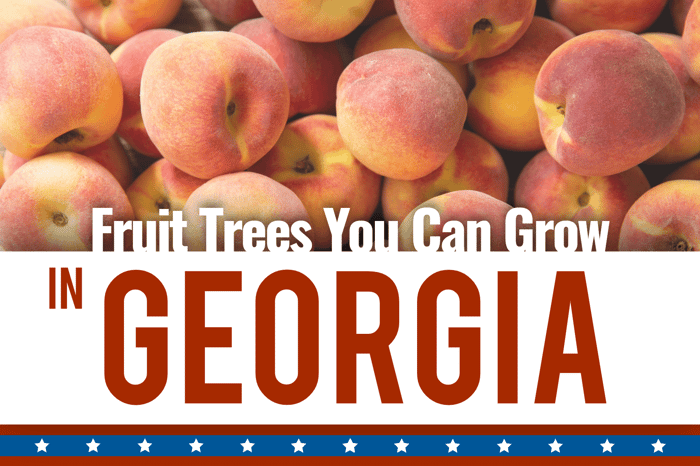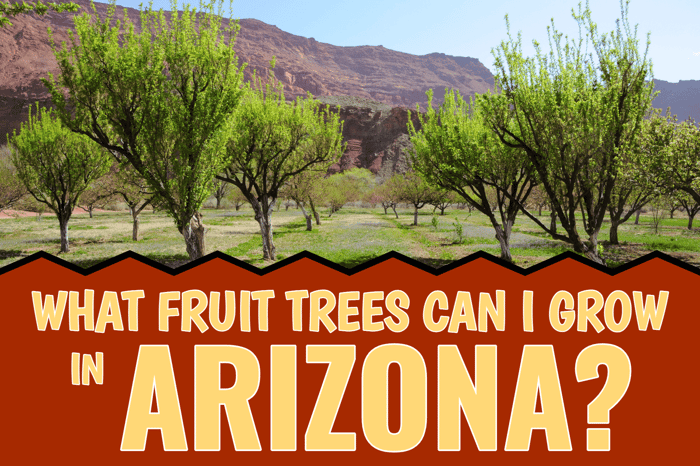Washington state growers produce over half of the nation's apple, pear, and cherry production. The state's cold winters, wet springs, and arid summers provide the perfect climate to grow and ripen delicious pome and stone fruits. Learn more about what fruit trees you can grow in Washington State.
All of the following recommendations are listed:
Fruit Tree: Variety (Required Chill Hours)
Persimmon Trees: Fuyu(200hr), Hachiya(200hr)
Persimmon growers in Washington state will have lots of success with Asian persimmon varieties both for their cold-hardiness and self-fruitful characteristics. These trees are adaptable to a variety of soil types and are drought tolerant once established. The heavy-bearing trees tend to be biennial-bearing due to heavy crops. Seasonal pruning and fruit thinning will help limit fruit production and overbearing. These long-living trees grow a deep taproot to which makes them generally larger trees and poor choices for container growing. Luckily the Asian varieties tend to produce smaller, more manageable trees.
Apple Trees: Gala(500hr), Golden Delicious(700hr), Fuji(500hr), Granny Smith(400hr), Pink Lady(300-400hr), Honey Crisp(800-1000hr)
Washington state produces over half of the nation's apples. The state's coastal and arid inland climates provide rich soil, and the abundance of water makes it ideal for almost any apple variety. Planting is simple, prepare your planting area with well-draining soil, dig a hole the same depth as the container of your tree, and plant so that the top of the root ball is flush with the soil level. Once planted you can top dress with a healthy dose of compost and mulch, making sure to leave space around the base of the tree to prevent stem rot. Pests and diseases plague apple trees so regular maintenance and spraying will be necessary for a good harvest. Apple trees should be pruned every winter/spring. They can be pruned to a variety of shapes and sizes depending on grower preference. The point of the process is to create airflow by removing crowded or damaged limbs, this will also allow more even light penetration, regulate the fruiting area, and improve the overall health of the tree.
Pear/Asian Pear Trees: Warren(600hr), Comice(600hr), Bartlett(550hr), D'Anjou(800hr), Hosui(300-400hr), 20th Century(300-400hr), Shinseiki(250-300hr)
Growing pears in Washington state is very similar to growing its apple relative. Accounting for over 80% of the nation's pear production, WA provides the perfect environment for pear trees. Both European & Asian Varieties thrive in this state and both have their unique flavors and textures. Pears tend to have more strict pollination requirements, so keep that in mind when choosing the right variety for your home orchard. For planting/maintenance guidance, follow the instructions listed above for apples as the steps will be the same. Pear trees also suffer from many of the same pests/diseases that plague apples so regular care will be necessary to keep your trees and surrounding trees healthy.
Cherry Trees: Bing(700), Lapins(400), Rainier(700), Stella(400), Montmorency(500)
Cherries can be grown in Washington with incredible results. Cherry trees are typically sold as bare root trees and should be planted in the fall/winter. This gives them enough time to get some roots developed before the season starts. Once established cherry trees are no easy feat as they take a good amount of protection if you want any of the bird's cherries for yourself. Between pests, birds, and disease, cherries need a regular schedule of spraying, pruning, and feeding if you want a good crop. Some growers also use nets to keep the larger pests out of your fruit trees. Stone fruit trees should be pruned to an open center to allow for airflow and more even ripening. That said, every grower has their preference, and trees can be pruned to any shape.
Apricot/Plum Trees: Blenheim Apricot(400hr), Gold Kist Apricot(300hr), Santa Rosa Plum(300hr), Methley Plum(250hr)
Apricots and Plums are great trees for the Washington garden. Not only do they produce wonderful fruit but they also produce a spectacular looking tree full of beautiful blooms in the spring. These lovely stone fruit trees prefer warmer climates so our growers in the southeast should have no problems, but growers further northwest may have issues ripening fruit and developing super sweet flavor. Plant your tree in a sunny part of the yard with well-draining soil and prune it to an open center to get your tree started. A regular watering schedule and feeding during the fruiting season will provide your tree with what it needs to succeed. Stone fruit trees are also incredibly susceptible to fungal and bacterial disease, so growers in the Puget region will need to spray and choose more resilient varieties. Untreated trees will produce less fruit and live short-lived lives.
Peach/Nectarine Trees: Elberta Yellow Peach(600hr), Suncrest Yellow Peach(500hr)/ Fantasia Yellow Nectarine(500hr), Goldmine White Nectarine(400hr)
While you shouldn't expect the same yield and flavor of a grower in Georgia, growing peaches and nectarines in Washington is certainly possible. You will have the same struggles as plums and apricots when it comes to disease and pest issues, so regular maintenance will be required. The maritime climate of the Puget Sound region makes for vary challenging growing conditions as moist conditions are perfect for invasive fungal disease. Though growers in the Southeast Basin region should be able to ripen up peaches and nectarines no problem due to the more arid climate. Variety selection will be key to your success in this area as choosing varieties that bloom too early will likely be damaged by late spring rains.
Jujube Trees: Li(200hr), GA 886(200hr), Shanxi Li(200hr), Sugar Cane(150hr)
The Jujube is an ancient tree that is just starting to dip into US gardens. The Jujube, also known as the Chinese date, has sweet, green/reddish-brown blotchy fruit that tastes almost apple-like in flavor and texture. They can be dried into a date-like treat that is chewy and sweet. They are extremely precocious and bear lots of fruit. Growing Jujubes in Washington is a piece of cake as these trees are heat tolerant(over 100°F), cold-tolerant(down to -10°F), and virtually pest and disease-free. The Jujube is also drought-resistant and is adaptable to a variety of soil types. Long hot summers are required to ripen the larger varieties so keep this in mind when selecting the right Jujube for your backyard.
Fig Trees: Brown Turkey(100hr), Black Mission(100hr), Kadota(100hr), Chicago Hardy(100hr)
Growing fig trees in Washington can be done in the ground or containers. The main thing to consider when deciding how to grow your fig tree is winter temperatures. Fig trees are cold tolerant down to about 5-10°F depending on the variety and age of the tree, but sub-zero temperatures will certainly kill them. Protecting your tree with a thick layer of mulch insulation before the cold weather arrives will help protect the base of the tree and roots. It is expected to see some dieback from frost damage in late winter/spring. Even if the tree dies back to the base, the roots will send up shoots that are true to type as they are propagated from cuttings. Winter frost damage can be avoided by growing your tree in a container and bringing the tree inside when you see that temperatures are going to drop.
Grapes: Ruby Seedless(100hr), Flame Seedless(100hr), Suffolk Red(100hr), Chardonnay(100hr), Concord"Eastern"(100hr)
Growing grapes in Washington can be a challenge but selecting the right variety and taking into consideration your microclimate will determine your success. There are a few regions in South/Southeast Washington that can provide adequate sun and heat to sweeten up fruit for table eating or winemaking. Like most fruit trees and vines, grapes prefer well-draining soil. They are also semi drought tolerant and have low water and fertilizer needs. Pruning plants in late winter/early spring will regulate tree growth and promote the overall health of the vine. Keep in mind when pruning that grapes are produced on spurs grown on one-year-old canes and be sure not to remove all of your fruit spurs. Pests and fungal diseases will be your biggest threat as they are typically brought on by a damp climate. A regular maintenance/spraying schedule will need to be set in place to produce a good crop. Maintenance will include pruning, cleaning up dead leaves, and any residual fruit left after harvest.
Pomegranate Trees: Wonderful(150hr), Desertnyi(200hr)
Some will tell you that growing Pomegranates in the Pacific Northwest cant be done, but I'm here to tell you that you can, and here's how. It won't be easy but with container growing and access to a greenhouse, you too can experience the wonders of a homegrown pomegranate. These desert-loving trees will have the most success in the more arid Southeast Basin where the temps are warmer and the weather is dryer. These trees require little water, almost no fertilizer, and minimal pruning in a container. The goal of container growing is to protect your tree from sub-freezing temperatures by bringing your tree indoors when temperatures drop. Place your tree in a south-facing location when kept outside and in a south-facing window of the house/greenhouse when brought indoors for maximum light exposure. For your tree/shrub to set fruit, adequate heat is a must so following the instructions above will be crucial.
Citrus Trees: All Citrus(Indoor/Outdoor)
Growing citrus in Washington can be done with lots of success. Citrus trees are tropical plants that love heat and humidity so simulating the right conditions will be tough but is not impossible. Citrus trees are only cold hardy to about 25-30°F depending on the variety so they need to be protected during the colder months and brought indoors. Thankfully Citrus trees in general are one of the few types of trees that do exceedingly well in containers. Lemons and Limes are the more cold-tolerant of the citrus family making them a great choice for an indoor/outdoor tree and will produce nearly year-round under adequate conditions. Follow our indoor citrus growing guide/pdf for more instruction on how to do this successfully.
Protect your fruit trees from the hot summer sun and winter cold with Plant Guard tree paint and foliar spray.
Author: Israel Osuna
Source: http://treefruit.wsu.edu/backyard-fruit-trees




